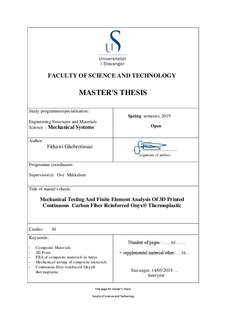| dc.contributor.advisor | Mikkelsen, Ove | |
| dc.contributor.author | Ghebretinsae, Fithawi | |
| dc.date.accessioned | 2019-10-08T17:53:47Z | |
| dc.date.available | 2019-10-08T17:53:47Z | |
| dc.date.issued | 2019-06 | |
| dc.identifier.uri | http://hdl.handle.net/11250/2621028 | |
| dc.description | Master's thesis in Mechanical Engineering | nb_NO |
| dc.description.abstract | While Additive manufacturing (AM) has been limited in prototyping and research areas, this technology has several advantages and significant potential to revolutionize nowadays conventional manufacturing processes. In recent years, several materials, including metals has been studied and tested in AM. However, polymers are the dominating currently available commercial materials. Polymers have low strength and stiffness, and their implementation in engineering applications that require high strength and stiffness is limited. However, by introducing a strengthening fiber, the polymer based material can turn into a stronger and stiffer material, namely, composite materials.
Currently, it is commercially possible to fabricate small size components from two or more filament materials using desktop 3D printers. However, there is limited understanding, on the material properties of the composites, produced by the 3D Print technology. To overcome this, there is a demand of several research both on the 3D printing processes and the material properties. This study was meant to provide more understanding on the parts fabricated from composite materials using 3D printer. Therefore, mechanical properties of 3D fabricated composite samples using Markforged® Mark-Two 3D printer were investigated. Tensile and flexural test had been carried out and the results were validated with Finite Element Analysis (FEA) results carried in ANSYS Mechanical Parametric Design Language (APDL) 17.0. Furthermore, carbon fiber (CF) as reinforcing, and “Onyx” as matrix materials were used in the fabrication of the test samples.
The tensile and flexural samples was fabricated with a fiber volume fraction of about 62% and 42%, respectively. Furthermore, the tensile samples provided 559.90 MPa and 25.04 GPa in maximum tensile strength and tensile modulus, respectively. Whereas 270.70 MPa in maximum flexural strength and 16.42 GPa in flexural modulus were achieved by the flexural samples. The obtained tensile strength and modulus results had a standard deviation of 17 MPa and 2.65 GPa, respectively. While the flexural strength and modulus results had a corresponding standard deviation of 28.30 MPa and 1.35 GPa. For comparison reasons, the ultimate tensile strength of 6061-T6 Aluminum, commonly used for bike frames, is 310 MPa . The tensile strength of composite samples in this study was about 80% higher than the strength of Al6061-T6. However, the tested samples contain high fiber volume fraction. | nb_NO |
| dc.language.iso | eng | nb_NO |
| dc.publisher | University of Stavanger, Norway | nb_NO |
| dc.relation.ispartofseries | Masteroppgave/UIS-TN-IMBM/2019; | |
| dc.rights | Navngivelse 4.0 Internasjonal | * |
| dc.rights | Navngivelse 4.0 Internasjonal | * |
| dc.rights.uri | http://creativecommons.org/licenses/by/4.0/deed.no | * |
| dc.subject | 3D printing | nb_NO |
| dc.subject | FEA of composite materials in Ansys | nb_NO |
| dc.subject | maskinteknikk | nb_NO |
| dc.subject | composite materials | nb_NO |
| dc.subject | mechanical testing of composite materials | nb_NO |
| dc.subject | continuous fiber reinforced Onyx® thermoplastic | nb_NO |
| dc.title | Mechanical Testing And Finite Element Analysis Of 3D Printed Continuous Carbon Fiber Reinforced Onyx® Thermoplastic | nb_NO |
| dc.type | Master thesis | nb_NO |
| dc.subject.nsi | VDP::Technology: 500::Mechanical engineering: 570::Machine construction and engineering technology: 571 | nb_NO |

